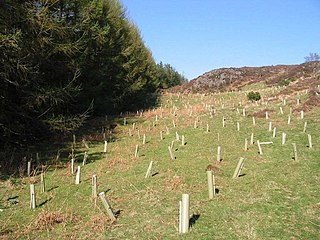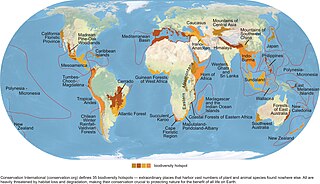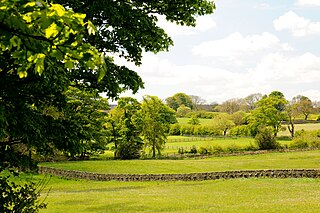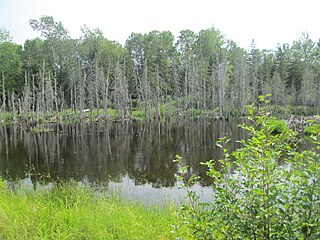
Resource depletion is the consumption of a resource faster than it can be replenished. Natural resources are commonly divided between renewable resources and non-renewable resources. The use of either of these forms of resources beyond their rate of replacement is considered to be resource depletion. The value of a resource is a direct result of its availability in nature and the cost of extracting the resource. The more a resource is depleted the more the value of the resource increases. There are several types of resource depletion, including but not limited to: mining for fossil fuels and minerals, deforestation, pollution or contamination of resources, wetland and ecosystem degradation, soil erosion, overconsumption, aquifer depletion, and the excessive or unnecessary use of resources. Resource depletion is most commonly used in reference to farming, fishing, mining, water usage, and the consumption of fossil fuels. Depletion of wildlife populations is called defaunation.
Conservation status is a measure used in conservation biology to assess an ecoregion's degree of habitat alteration and habitat conservation. It is used to set priorities for conservation.

Habitat conservation is a management practice that seeks to conserve, protect and restore habitats and prevent species extinction, fragmentation or reduction in range. It is a priority of many groups that cannot be easily characterized in terms of any one ideology.

Land development is the alteration of landscape in any number of ways such as:

Habitat destruction occurs when a natural habitat is no longer able to support its native species. The organisms once living there have either moved to elsewhere or are dead, leading to a decrease in biodiversity and species numbers. Habitat destruction is in fact the leading cause of biodiversity loss and species extinction worldwide.

Carbon offsetting is a carbon trading mechanism that enables entities to compensate for offset greenhouse gas emissions by investing in projects that reduce, avoid, or remove emissions elsewhere. When an entity invests in a carbon offsetting program, it receives carbon credit or offset credit, which account for the net climate benefits that one entity brings to another. After certification by a government or independent certification body, credits can be traded between entities. One carbon credit represents a reduction, avoidance or removal of one metric tonne of carbon dioxide or its carbon dioxide-equivalent (CO2e).
Mitigation is the reduction of something harmful that has occurred or the reduction of its harmful effects. It may refer to measures taken to reduce the harmful effects of hazards that remain in potentia, or to manage harmful incidents that have already occurred. It is a stage or component of emergency management and of risk management. The theory of mitigation is a frequently used element in criminal law and is often used by a judge to try cases such as murder, where a perpetrator is subject to varying degrees of responsibility as a result of one's actions.

A biodiversity action plan (BAP) is an internationally recognized program addressing threatened species and habitats and is designed to protect and restore biological systems. The original impetus for these plans derives from the 1992 Convention on Biological Diversity (CBD). As of 2009, 191 countries have ratified the CBD, but only a fraction of these have developed substantive BAP documents.

Mitigation banking is a market-based system of debits and credits that involves restoration, creation, or enhancement of wetlands to compensate for unavoidable impacts to a wetland in another location. It involves a system of mitigation banks, sites where projects to restore, create, or enhance wetlands can be carried out in advance of impacts. The outcomes of these projects are valued through the creation of compensatory mitigation credits that can be purchased from mitigation banks to offset the negative impacts of developments or agriculture expansion on wetlands and aquatic habitats. This process is generally conducted with the aim of achieving no net loss of function and value for specific aquatic habitats, such as in terms of the biodiversity or ecosystem services provided by a wetland.
This is a glossary of environmental science.

Wetland conservation is aimed at protecting and preserving areas of land including marshes, swamps, bogs, and fens that are covered by water seasonally or permanently due to a variety of threats from both natural and anthropogenic hazards. Some examples of these hazards include habitat loss, pollution, and invasive species. Wetland vary widely in their salinity levels, climate zones, and surrounding geography and play a crucial role in maintaining biodiversity, ecosystem services, and support human communities. Wetlands cover at least six percent of the Earth and have become a focal issue for conservation due to the ecosystem services they provide. More than three billion people, around half the world's population, obtain their basic water needs from inland freshwater wetlands. They provide essential habitats for fish and various wildlife species, playing a vital role in purifying polluted waters and mitigating the damaging effects of floods and storms. Furthermore, they offer a diverse range of recreational activities, including fishing, hunting, photography, and wildlife observation.
Biodiversity banking, also known as biodiversity trading, conservation banking, mitigation banking, habitat banking, compensatory habitat, or set-asides, describes a market-based framework for biodiversity offsetting where offsets can be traded in the form of credits to offset negative environmental impacts of development projects or activities. This involves biodiversity banks, areas with biodiversity value. On the site of a biodiversity bank, conservation activities may be carried out to preserve, restore, enhance, or conserve biodiversity. The outcomes of projects carried out at biodiversity banks are valued in the form of credits, which can be purchased as a way to offset unavoidable adverse environmental impacts, often with the aim of achieving no net loss of biodiversity.

"No net loss" is the United States government's overall policy goal regarding wetlands preservation. The goal of the policy is to balance wetland loss due to economic development with wetlands reclamation, mitigation, and restorations efforts, so that the total acreage of wetlands in the country does not decrease, but remains constant or increases.

Environmental impact of mining can occur at local, regional, and global scales through direct and indirect mining practices. Mining can cause erosion, sinkholes, loss of biodiversity, or the contamination of soil, groundwater, and surface water by chemicals emitted from mining processes. These processes also affect the atmosphere through carbon emissions which contributes to climate change.

Biodiversity offsetting is a system used predominantly by planning authorities and developers to fully compensate for biodiversity impacts associated with economic development, through the planning process. In some circumstances, biodiversity offsets are designed to result in an overall biodiversity gain. Offsetting is generally considered the final stage in a mitigation hierarchy, whereby predicted biodiversity impacts must first be avoided, minimised and reversed by developers, before any remaining impacts are offset. The mitigation hierarchy serves to meet the environmental policy principle of "No Net Loss" of biodiversity alongside development.
The Lacassane Company is a land management company, with a goal of sustainable land management using an environmental management scheme that involves a host of tools including holistic management. Located primarily in Jefferson Davis and Cameron parish, with property in Ragley, Louisiana, the company headquarters is in Lake Charles, Louisiana.

Conservation banking is an environmental market-based method designed to offset adverse effects, generally, to species of concern, are threatened, or endangered and protected under the United States Endangered Species Act (ESA) through the creation of conservation banks. Conservation banking can be viewed as a method of mitigation that allows permitting agencies to target various natural resources typically of value or concern, and it is generally contemplated as a protection technique to be implemented before the valued resource or species will need to be mitigated. The ESA prohibits the "taking" of fish and wildlife species which are officially listed as endangered or threatened in their populations. However, under section 7(a)(2) for Federal Agencies, and under section 10(a) for private parties, a take may be permissible for unavoidable impacts if there are conservation mitigation measures for the affected species or habitat. Purchasing “credits” through a conservation bank is one such mitigation measure to remedy the loss.

Canadian wetlands account for approximately one quarter of the world's total wetlands and is ranked with the highest surface area of wetlands on the Ramsar Conventions List of Wetlands of International Importance. Canada holds 37 designated areas of International Importance which equates to approximately 13,086,767 hectares of land.
A Biodiversity Impact Credit (BIC) is a transferable biodiversity credit designed to reduce global species extinction risk. The underlying BIC metric, developed by academics working at Queen Mary University of London and Bar-Ilan University, is given by a simple formula that quantifies the positive and negative effects that interventions in nature have on the mean long-term survival probability of species. In particular, an organisation's global footprint in terms of BICs can be computed from PDF-based biodiversity footprints. The metric is broadly applicable across taxa and ecosystems. Organisations whose overall biodiversity impact is positive in terms of the BIC metric contribute to achieving the objective of the Global Biodiversity Framework to "significantly reduce extinction risk".
Nature positive is a concept and goal to halt and reverse nature loss by 2030, and to achieve full nature recovery by 2050. According to the World Wide Fund for Nature, the aim is to achieve this through "measurable gains in the health, abundance, diversity, and resilience of species, ecosystems, and natural processes." Progress towards this goal is generally measured from a biodiversity baseline of 2020 levels.














